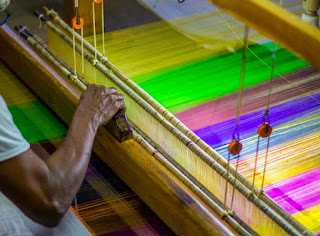Save the Textile Industry
JAKARTA - Chairman of the Indonesian Textile Association (API) Ade Sudrajat asked the government to speed up negotiations on Indonesia's participation in transpacific Cooperation (Trans-Pacific Partnership / TPP) led by the United States (US). Therefore, the TPP could save the textile industry and textile products (TPT) from adversity.
In the past five years, textile exports continued to sag. Based on the Central Statistics Agency (BPS), exports in 2011 reached US $ 13.17 billion down to US $ 12.33 billion in 2015.

By contrast, imports rose from US $ 6.52 billion in 2011 to US $ 6.95 billion in 2015. As a result, the textile trade surplus continued to fall and the domestic market is flooded with imported products. Now, the local textile market share in the domestic market only 30%.
Ade said the TPP is a necessity for textile entrepreneurs, because it can increase foreign exchange earnings and employment. Indonesia started exporting textile to the US in the 1980s. However, in the past five years, exports to Uncle Sam stagnant.
"We just want the government to focus on the TPP, because the benefits greatly to the textile industry," he said at the National Conference on JIExpo API, Kemayoran, Jakarta, Wednesday (27/4).
Ade projecting, if Indonesia joined TPP, textile exports will increase three-fold and the absorption of employment rose to double to 4 million people from the current 2 million.
He added, the domestic market has been widely attacked by products imported from China. That means, local products already compete. Thus, the only way to increase sales is through exports. "We want to join TPP Indonesia and we hope many in the current administration," he said.
TPP 12 participating countries agreed on October 5, 2015 and TPP pact was signed in early February 2016. To apply TPP requires parliament's approval of each country before it can take effect. This trade agreement is the largest in history for representing approximately 36.26% of the world GDP, or about US $ 28.03 billion.
Deepening Industry
Meanwhile, data from the Ministry of Industry (Ministry of Industry) states, in February 2016, the value of textile exports rose by 6.81% when compared to January. This industry is a labor-intensive industry, which is able to absorb the labor force of 1.5 million people, or about 10.36% of the workforce in the manufacturing sector. In Indonesia, the deepening of solid textile industry, because it has been integrated from upstream to downstream. In fact, the products are also known to have good quality in the international market.
"We're targeting the textile non-woven (material replacement for plastic and paper) and the future will continue to be strengthened. It is part of a strategy of product diversification as well the expansion of export marketing," said Minister of Industry Saleh Husin at the opening of the National Conference API 14th once inaugurated Exhibition Indo Intertex, Inatex, Indo Dyechem, and Indo Texprint in JI-Expo.
Products used for the non-woven material toll road infrastructure development, agro-textiles, medical, food and beverage industry, the automotive industry and other manufacturing industries consumption. Development of products that contribute to strengthen the competitiveness which is becoming stronger capital for the national textile industry. Moreover, the textile market is still wide and also a great demand.
"In the last five years, the average demand increased by 9.9% per annum, of which Indonesia could only supply 0.47% of the world," he said.
Source: Investor Daily
In the past five years, textile exports continued to sag. Based on the Central Statistics Agency (BPS), exports in 2011 reached US $ 13.17 billion down to US $ 12.33 billion in 2015.

By contrast, imports rose from US $ 6.52 billion in 2011 to US $ 6.95 billion in 2015. As a result, the textile trade surplus continued to fall and the domestic market is flooded with imported products. Now, the local textile market share in the domestic market only 30%.
Ade said the TPP is a necessity for textile entrepreneurs, because it can increase foreign exchange earnings and employment. Indonesia started exporting textile to the US in the 1980s. However, in the past five years, exports to Uncle Sam stagnant.
"We just want the government to focus on the TPP, because the benefits greatly to the textile industry," he said at the National Conference on JIExpo API, Kemayoran, Jakarta, Wednesday (27/4).
Ade projecting, if Indonesia joined TPP, textile exports will increase three-fold and the absorption of employment rose to double to 4 million people from the current 2 million.
He added, the domestic market has been widely attacked by products imported from China. That means, local products already compete. Thus, the only way to increase sales is through exports. "We want to join TPP Indonesia and we hope many in the current administration," he said.
TPP 12 participating countries agreed on October 5, 2015 and TPP pact was signed in early February 2016. To apply TPP requires parliament's approval of each country before it can take effect. This trade agreement is the largest in history for representing approximately 36.26% of the world GDP, or about US $ 28.03 billion.
Deepening Industry
Meanwhile, data from the Ministry of Industry (Ministry of Industry) states, in February 2016, the value of textile exports rose by 6.81% when compared to January. This industry is a labor-intensive industry, which is able to absorb the labor force of 1.5 million people, or about 10.36% of the workforce in the manufacturing sector. In Indonesia, the deepening of solid textile industry, because it has been integrated from upstream to downstream. In fact, the products are also known to have good quality in the international market.
"We're targeting the textile non-woven (material replacement for plastic and paper) and the future will continue to be strengthened. It is part of a strategy of product diversification as well the expansion of export marketing," said Minister of Industry Saleh Husin at the opening of the National Conference API 14th once inaugurated Exhibition Indo Intertex, Inatex, Indo Dyechem, and Indo Texprint in JI-Expo.
Products used for the non-woven material toll road infrastructure development, agro-textiles, medical, food and beverage industry, the automotive industry and other manufacturing industries consumption. Development of products that contribute to strengthen the competitiveness which is becoming stronger capital for the national textile industry. Moreover, the textile market is still wide and also a great demand.
"In the last five years, the average demand increased by 9.9% per annum, of which Indonesia could only supply 0.47% of the world," he said.
Source: Investor Daily


Comments
Post a Comment